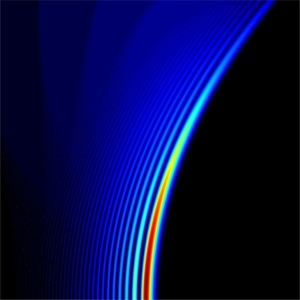As we all know, light on its own tends to travel in a straight line. When it gets sent through an aperture like a flashlight, diffraction occurs, which causes the beam to widen and lose its intensity.
In some cases, though, light can be made to travel an arced path instead of a straight line. This is possible if the light’s waveform is shaped in a certain way, and is referred to as Airy Beams after Sir George Biddell Airy who developed a function that describes these arcs while studying the light properties of rainbows.

Airy beam bends sideways by about 1 mm over the 35-cm section in computer simulation (Image via physics.aps.org)
Recently, a team or researchers in Israel discovered a way of taking the process of creating light-based Airy Beams and applying them to electron beams instead.
Background on Airy Beams
In order to go over how they did this, it’s important to understand that, according to quantum physics, waves and particles are characteristics of the same scheme; that is, a particle’s trajectory is determined by its waveform. When light particles move through an opening, whether it’s something like a flashlight or lantern, each particle interferes with the others, which results in all of them having their trajectory disturbed. This is what causes the diffraction.
In 2007, researchers discovered a way to create Airy Beams. Without getting too granular with the details, the researchers manipulated the waveform of each particle in the same manner so that the entire light beam could follow a curved path. Each particle did not interrupt its neighbor’s trajectory which, in turn, mitigated the beam’s diffraction and allowed the light to retain its intensity over longer distances.
An electron-based Airy Beam
This brings us to today. In order to generate an Airy beam using electrons, the team massaged the wave function of electrons in an electron beam by shooting it through a specially designed hologram that had a pattern designed specifically to cause a desired curve. It was kept focused via magnetic field. The result was a triangularly shaped bundle of beams, each of which followed its own an arced path.
One of the things the researchers noticed when studying these beams — which they didn’t expect to find — was that the electron-based Airy Beams were also self-healing. If they ran into an object (a glass wire was used as an example), they simply reformed on the other side.
Outlook
While further research and testing are still needed, an electron-based Airy Beam will likely see immediate use in developing better tunneling electron microscopes. Looking down the road, the technology will also likely be further researched to see what happens with the electron beam as it is made to travel greater and greater distances.
The group’s work was published in Nature under the title Generation of Electron Airy Beams. It is available online for purchase.
Share your thoughts on this new technology in the power solutions forum on DigiKey’s TechXchange.
Advertisement





